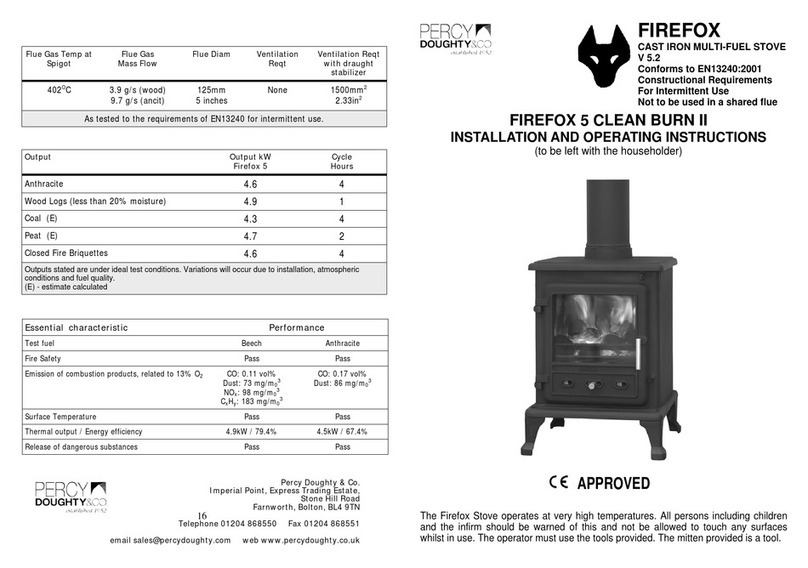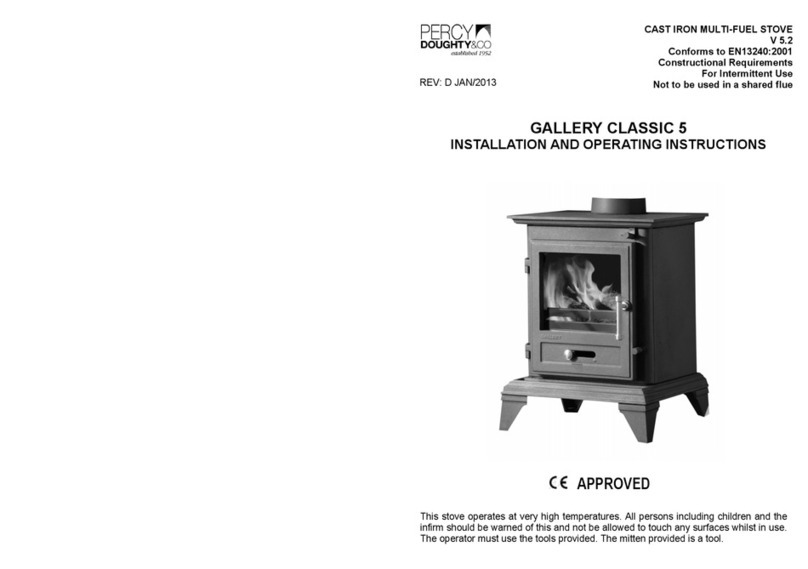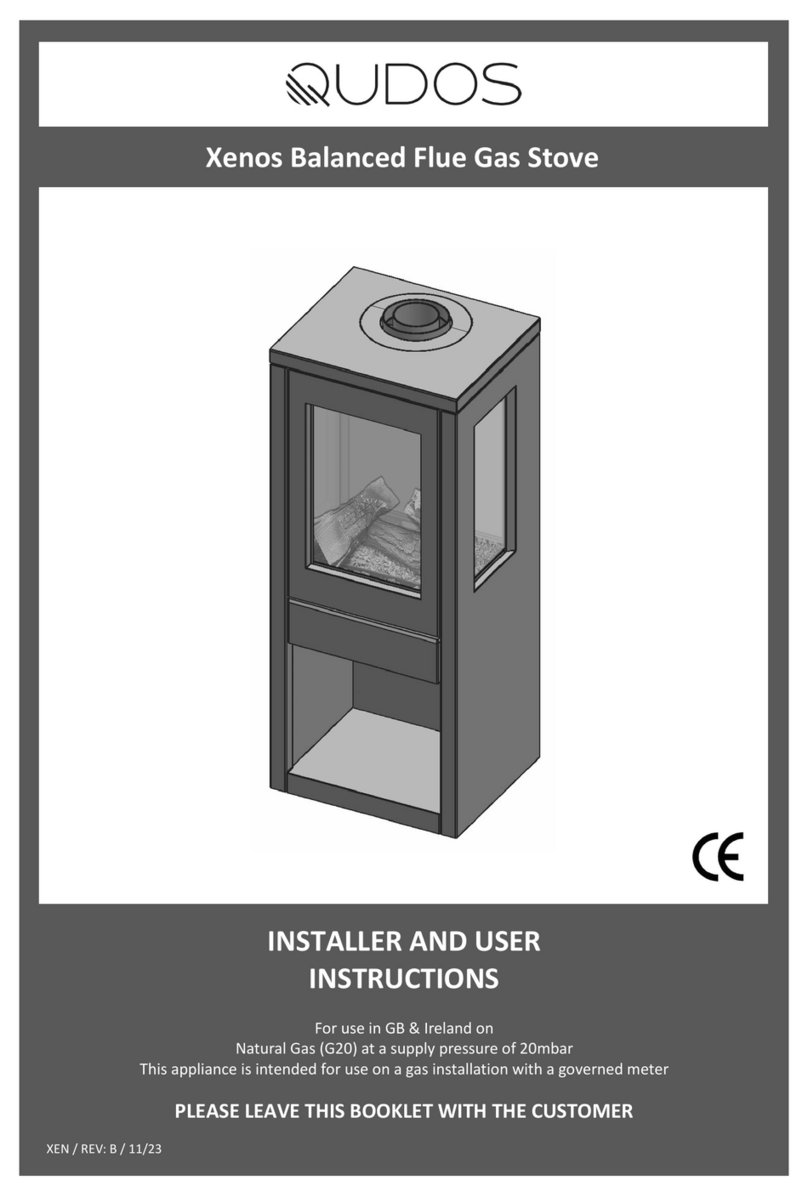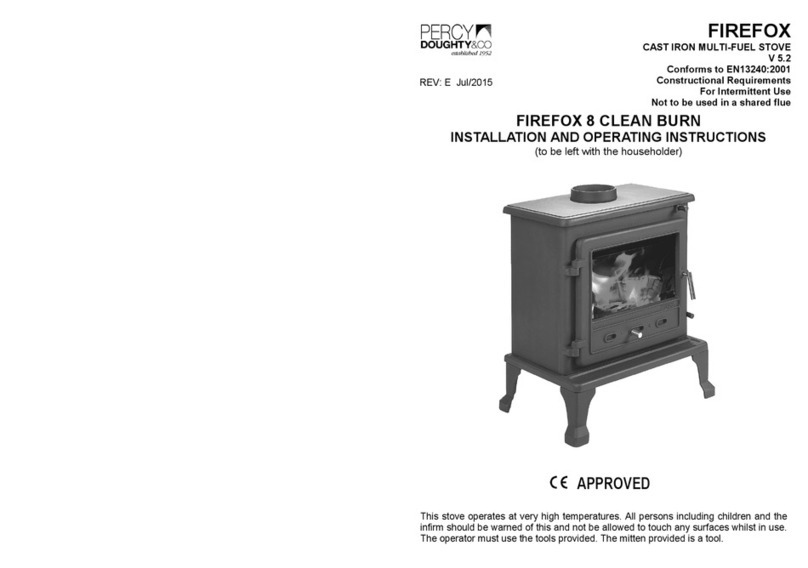8
Should any difficulties arise over fuel quality or suitability, consult your local supplier or
the Solid Fuel Advisory Service.
Safety Notes For Your Guidance
FIRES CAN BE DANGEROUS –Always use a fire guard in the presence of children,
the elderly of the infirm.
Inform all persons the dangers of high temperatures during operation of appliance in-
cluding the stove pipe use operating tools provided.
DO NOT OVER FIRE—it is possible to fire the stove beyond its design capacity, this
could damage the stove, so watch for signs of overfiring—if any part of the stove starts
to glow red, the fire is in an overfire situation, and the controls should be adjusted ac-
cordingly. Never leave the stove unattended for long periods without adjusting the con-
trols to a safe setting—careful air supply control should be exercised at all times.
Warning—Fume Emissions
Properly installed and operated, this appliance will not emit fumes. Occasional fumes
from de-ashing and refuelling may occur. Persistent fume emission must not be toler-
ated.
If fume emission does persist, then following immediate action should be taken—
1. Open doors and windows to ventilate the room.
2. Let the fire out, or eject and safely dispose of fuel from the appliance.
3. Check for flue chimney blockage, and clean if required.
Do not attempt to relight the fire until the cause has been identified. If necessary, seek
professional advice.
DO NOT FIT AN EXTRACTOR FAN IN THE SAME ROOM AS THIS APPLIANCE
General Maintenance
Baffle Plate
This should be removed at least once a month to prevent any build up of soot or fly ash
which could lead to blocked flueways and dangerous fume emission. If the baffle plate
is removed the chimney/flueway can be swept through the appliance.
Stove Body
The stove is finished with a heat-resistant paint and this can be cleaned with a soft
brush. Do not clean whilst the stove is hot, wait until it has cooled down. The finish can
be renovated with a suitable brand of paint.
Glass Panels
Clean the glass panels when cool with a proprietary glass cleaner. Highly abrasive
substances should be avoided as these can scratch the glass and make subsequent 9
cleaning more difficult. Wet logs on heated glass, a badly aimed poker or heavy slam-
ming of the doors could crack the glass panels. The glass will not fracture from heat.
Chimney
Check your chimney each year before starting to use your stove for the winter. Birds
may have nested in the chimney or the masonry may have cracked. Both chimney and
flue pipe must be swept at least once a year.
To avoid a build up of soot on the baffle (the plate inside the stove above the grate)
this must be removed and cleaned periodically. This plate locates the back and side
firebricks so note its position before removal. To remove, lift up centre section of baffle
plate and manipulate through the gap in the outer baffle plate. Then, by lifting the outer
plate at one side, remove the firebrick beneath. The outer plate can now be withdrawn.
Clean off any residual soot from the flueway and baffle plate and replace in reverse
order of removal. Check that the plates are located correctly. This must be done when
the stove is cold.
For efficient burning of your appliance, make sure the grate is clear of burnt debris i.e.
nails etc.
Troubleshooting
1) Poor heat output
A) Stove too small for a room.
Seek advise from a Qualified Heating Engineer as to (KW) output required for
room size as a guideline the volume of the room in cubic feet divided by 500 i.e.
room 15’x15’x8’ would require 3.6kw approx.
B) Chimney and/or flue pipe restricted, room ventilation restricted.
On installation these will have been checked but regular maintenance is neces-
sary as conditions can change i.e. soot build up, birds nesting, masonry fall, dust
build up or furniture blocking vents.
C) Poor quality fuel.
Only burn dry seasoned timber, soft woods have a lower heat output then hard
woods per hour. Solid fuels vary in heat value check with your coal merchant as
to suitability.
2) Dirty Glass Panel
A) Generally caused by poor fuel quality, see (1c)
B) Use secondary air slide (Airwash) for glass panel
C) Fire burning to low, open air vents on stove create hot fire this may ‘burn’ glass
clean.
D) If glass requires cleaning use glass cleaner recommended by your supplier,
only use glass cleaner or cold glass. DO NOT USE any abrazifs or scrapers these
will scratch glass causing tar build up harder to remove.

































